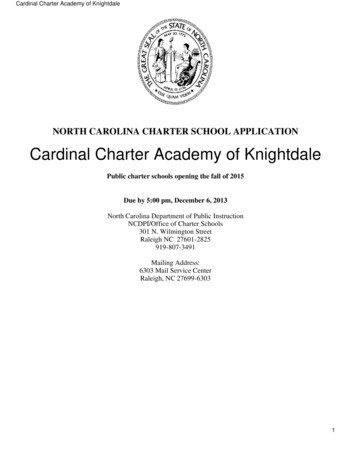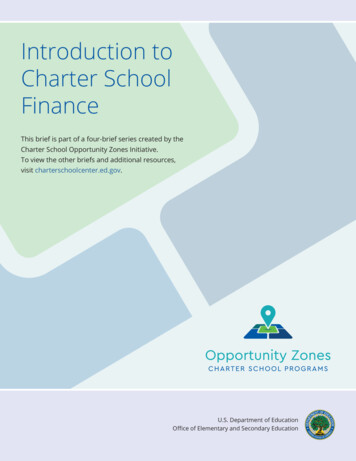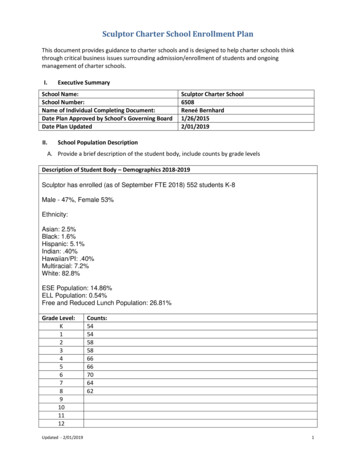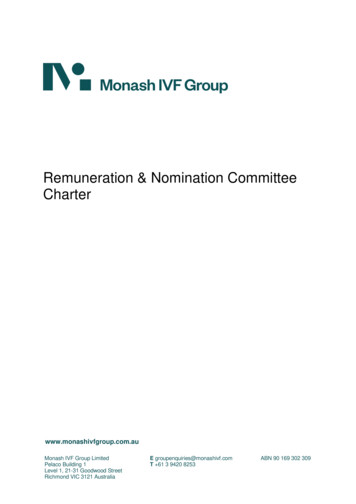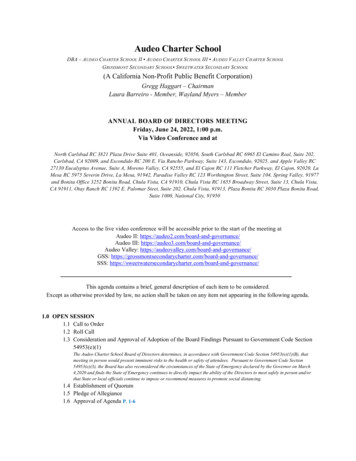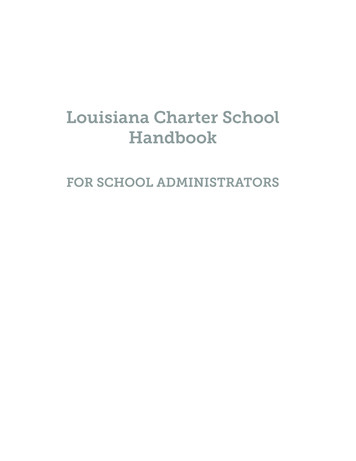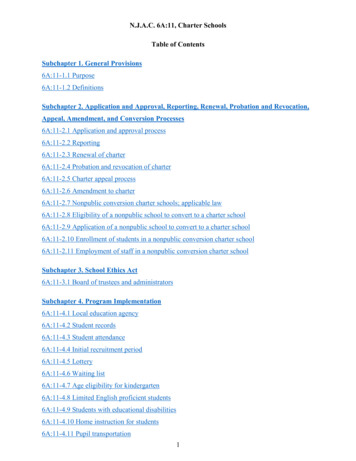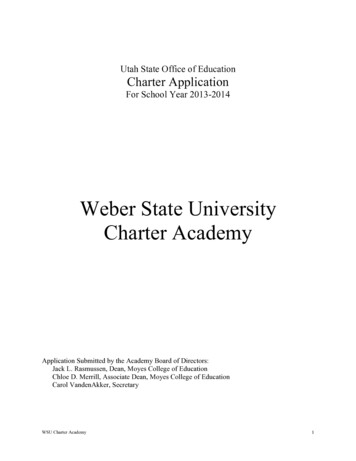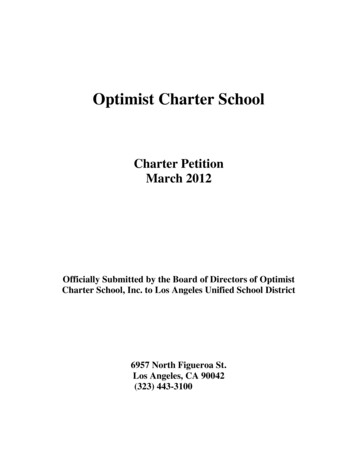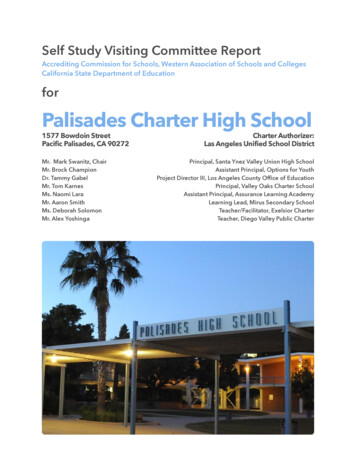
Transcription
Self Study Visiting Committee ReportAccrediting Commission for Schools, Western Association of Schools and CollegesCalifornia State Department of EducationforPalisades Charter High School1577 Bowdoin StreetPacific Palisades, CA 90272Mr. Mark Swanitz, ChairMr. Brock ChampionDr. Tammy GabelMr. Tom KarnesMs. Naomi LaraMr. Aaron SmithMs. Deborah SolomonMr. Alex YoshingaCharter Authorizer:Las Angeles Unified School DistrictPrincipal, Santa Ynez Valley Union High SchoolAssistant Principal, Options for YouthProject Director III, Los Angeles County Office of EducationPrincipal, Valley Oaks Charter SchoolAssistant Principal, Assurance Learning AcademyLearning Lead, Mirus Secondary SchoolTeacher/Facilitator, Exelsior CharterTeacher, Diego Valley Public Charter
PrefacePalisades Charter High School's Self Study process was consistent with theexpectations outlined in the Western Association of Schools and Colleges' Joint ACSWASC/CDE Process Guide 2017 Edition. Data collection, training and organization forthe self-study commenced in Fall 2016. Starting in Spring 2017, focus groupscomposed of administrators, certificated staff members, classified staff members,students and community members were formed and began to review the school'smission and vision the revision process of the Student Learning Outcomes (SLO). InFall 2017, home groups were added to the process and began working in concertwith the focus groups to gather information, analyze data and summarize results.Periodically WASC leadership consulted with specific faculty groups, special teams,classified staff and groups of students and parents to deepen their understanding oftheir school.The Spring 2017 focus group work resulted in the adoption of the Palisades CharterHigh School Student Learning Outcomes (SLO) which consisted of what they refer toas the Four Cs:Core Learning: Students will meet or exceed the StateStandards in all disciplines.Critical Thinking: Students will develop critical thinkingskills which enable them to evaluate, analyze, and synthesizeinformation to make decisions and solve problems.Communication: Students will communicate effectively byusing various formats including listening, visual, oral, written,and technological skills.Community, Consideration, and Compassion: Studentswill interact respectfully and work effectively in diversegroup settings both within the school and the greatercommunity.PCHS has struggled in recent years with the gathering and analyzing of data aboutstudents and student achievement. Due to the shift to the new California assessmentsystem, there was a dearth of local assessments and other state-wide testing. Thathas caused challenges for decision-making as it has not been wholly informed byquantitative, qualitative, and observational data from summative assessments. This
lack of accessible data impacted decision-making related to instruction andprofessional development resource allocation.PCHS has adopted an assessment model utilizing multiple measures to assess theeffectiveness of the instructional program and its impact on student learning. Aspresented in the school’s self-study and discussed during the accreditation visit, theassessment model includes measures of student outcomes listed below:Major Assessment Measures English language acquisition of English learners‣ achievement on the CELDT assessments‣ rates of reclassification of English language learners (ELLs) from limited-Englishproficient (LEP) to fluent-English proficient (FEP) Indicators of college preparation PSAT results SAT scores Advanced Placement Enrollments in AP coursework AP tests taken Students’ pass rates on AP tests Grade 11 students’ English and math achievement levels on the Smarter BalancedAssessment, which measures progress toward proficiency on the Common coreEnglish and math standards Assessment of students’ school attendance ADA rates Student tardies Full-period truancies Numbers of chronic absentees Student dropout rate Student in-class performance Student GPA data Students with “D” or “F” grades at the regular grading periods Students performance on the California Physical Fitness Tests Student graduation ratesAdditional Measures of Student AchievementPCHS staff also analyzes the following: Student discipline data Student enrollment and completion of dual-enrollment coursework
Students’ participation in the school’s sports programStudents earning the State Seal of Bi-literacyResponses to “school satisfaction” surveys of students, parents, and staffResults from the biannual California Healthy Kids SurveyDevelopment by staff of interim assessments are underway to measure students’skill and knowledge levels on the English, Math, Science, and Social Science corestandardsPCHS staff analyze student performance on multiple measures on a regular basis, andtrack student outcomes over time (at least three-year trends) when appropriate. Viathe analysis of student achievement data “achievement gaps” are identified bycomparing the norm of student achievement to that of special population students,such as Hispanic students, economically disadvantaged students, and Englishlearners.Staff agreed to a WASC Action Plan that aligned with the school's Long-Term StrategicPlan (LTSP) which was has morphed with the advent of the Local Control FundingFormula (LCFF) into the school’s Local Control Accountability Plan (LCAP) as noted inthe school's self-study and discussions with the leadership team.
Chapter 1: Progress ReportFollowing their 2012 WASC accreditation, Palisades High School established a LongTerm Strategic Planning Committee (LTSPC) to continuously refine and reshape itsmission, vision, values, and goals to meet student needs. The LTSPC embedded the2012 WASC Action Plan goals and Visiting Committee recommendations into theirplan and the school Local Control Accountability Plan (LCAP). The LTSPC annuallymeasures the school's progress towards meeting these goals and revises andupdates the plans accordingly. The five standing subcommittees of the LTSPC,Academic Achievement and Innovation, Facilities, Family and Community,Fundraising and Development, and Technology meet monthly.In 2012, PCHS's Action plan included the following four goals:1. Demonstrate continuous growth in academic achievement across all studentgroups.2. Strengthen the Pyramid of Interventions Response to Intervention (RtI) model atPCHS.3. Refine Professional Learning Communities already established at PCHS4. Upgrade facilities and improve technology.In addition, the recommendations of the 2012 WASC Visiting Committee as Areas ofFocus for PCHS were:1. Create a bell schedule that allows for more PLC and professional development,collaborative time and maximizes instructional minutes.2. Implement the facility modernization master plan.3. Fully develop all PLCs.4. Implement a current, integrated data system.5. Develop and implement a coordinated professional development program.6. Develop a comprehensive teacher evaluation.7. Develop and implement a clear, systemic school-wide RtI model.Since 2012, PCHS has made the greatest progress in meeting their goals in thefollowing areas:
Teacher evaluationProfessional Learning Community (PLC) developmentAcademic and personal support for studentsProfessional DevelopmentFacilitiesTechnologySpecifically, In 2013-14, PCHS adopted and implemented a new teacher evaluation systembased on the California Beginning Teacher Support and Assessment (BTSA)Program and the California Standards for the Teaching Profession (CSTP) whichfeatures a rubric and specific procedures designed to provide teachers withongoing meaningful constructive feedback and targeted professionaldevelopment. PCHS has fully embraced the Professional Learning Community (PLC) model. Aftersome early grade-level pilots with PLCs, in the 2014-15 school year, PCHS createdthe position of PLC Coordinator which renewed the faculty's focus on instructionresulting in significant improvement in course alignment with standards, commonpacing plans, seamless integration of new standards, horizontal and verticalarticulation within departments, common assessments and rubrics, curriculardevelopment and collaboration. The model has undergone considerablereevaluation and refinement in the last several years and continues to do so. The addition of an academic counselor and reallocated resources to hire a parttime Intervention Counselor to run Student Success Team (SST) meetings isdesigned to support the closing of the achievement gap and ensure appropriateat-risk students are placed in appropriate support classes. The InterventionCounselor regularly communicates with general and special education teachers aswell as counselor and other support staff to monitor at-risk students. Tutoringofferings have increased since 2012. All teachers are contractually obligated tooffer one office hour per week in support of student success. PCHS has increasedor revamped alternative education options including operation of the rebranded/restructured Pali Academy, a former Los Angeles Unified School Districtcontinuation school, adding the Pali Online Program (POP) to support creditdeficient students, and adding a new position, Campus Unification Director,responsible for campus-wide safety, respect, and social justice through clubs and
other programs designed to provide targeted social emotional intervention andsupport. [Consider adding other interventions after on-site visit] Funding for professional development has increased since 2012 and funding forsummer curriculum work has been restored. PCHS has further developed theircomprehensive professional development program including individual and PLCbased professional development. PCHS has severed ties with LAUSD for facilities maintenance since 2012 and nowcontracts privately for services previously provided by the charter authorizer. Majorimprovements have been made to performing arts spaces. A former shop spacewas converted into a special education learning center. Classrooms and restroomshave been renovated, and a host of other minor improvements have occurred.Infrastructure improvements include adding schoolwide Wi-Fi, repairing andreplacing water valves and pipes, upgraded HVAC units and air handlers, and theinstallation of new signage. Athletic facilities have been upgraded, and a newsecurity camera system has been installed. Numerous other smaller projects havealso been completed since the last accreditation visit. In the area of technology, PCHS has adopted and implemented a new studentinformation system, communication system, learning management system, datacollection and analysis system (in progress) and greatly enhanced classroomtechnology, among other advances. With these rapid schoolwide adoptions havecome some growing pains, as Pali staff have recognized the importance ofinteroperability, cross-platform data porting, and digital equity. They continue toproactively tackle these issues on multiple fronts.
Chapter 2: Student/Community ProfileOriginally founded as a traditional public high school in 1961, Palisades became adependent charter in 1993, then subsequently became independent in 2003. Today,Pali High as it is commonly referred to, is a robust comprehensive high school whichmaintains long-standing traditions of community activism, school involvement, andeducational excellence. Its mission is to create global citizenship taught throughdiverse perspectives. Students who come to Palisades Charter High School areattracted by its reputation for excellence in both its academic and activity programs.In 2016, the California Department of Education selected Palisades Charter HighSchool as a California Gold Ribbon School, distinguished by its exceptional academicprograms. PCHS was one of 180 secondary schools that were honored by theCalifornia Department of Education. PCHS was designated by Newsweek, WorldReport, and niche.com as a top-ranking school in California and the nation.Palisades Charter High School (PCHS) has provided students from far-reaching areasof the greater Los Angeles area with access to a high-quality educational programthat focuses on skills needed for college and career readiness. PCHS is the homeschool to students residing in the communities of Pacific Palisades, Topanga, andBrentwood; however, approximately 68% at the school live outside the traditionalattendance boundaries. In 2016-17, PCHS served 2,893 students. Of these students,1976 come from more than 113 ZIP codes, making this student body population oneof the most ethnically diverse schools in Los Angeles. The demographics of thestudent body include Hispanic, African American, Chinese, Korean, Persian, Filipino,Russian, Pacific Islander, Arabic, and Brazilian students. Many students commit tomaking daily one to three-hour commutes to and from the campus in order to takeadvantage of the school’s highly regarded academic, athletic, and arts programs. Dueto the sponsor district's defunding of transportation for students from outside theattendance area who want to attend Pali High, the demographics are shifting. Therehas been an overall increase in the number of affluent white students while AfricanAmerican and Hispanic students represent just 35% of the population down from 47%in 2004.As it has for so many California schools, the gap in State standardized test andaccountability data in the past several years has impacted Palisades Charter's
schoolwide analysis of its programs. The school recognizes that they have work to doin more effectively gathering and systematically using schoolwide data; however, theirPLCs are using common assessments in Mastery Manager and other locally sourceddata to inform their practice, and other data sets are gathered; however, until recently,there has not been a central repository for, nor a systemic plan for the analysis ofschoolwide data.The school has relied on CAASPP and other more generally broad data as markers ofstudent progress.2-Year Schoolwide ComparisonCAASPP ELA % Met or Exceeded80%60%40%20%0%2015California2016LA CountyLAUSDPCHS
Schoolwide ComparisonCAASPP Math % Met or Exceeded60%45%30%15%0%2015California2016LA CountyLAUSDPCHSPCHS Disaggregated 2016CAASPP ELA % Met or Exceeded100%75%50%25%0%AllMale FemaleDid Not MeetWhite Hispanic AsianBlackNearly MetMetSED DisabilityExceeded
PCHS Disaggregated 2016CAASPP Math % Met or Exceeded100%75%50%25%0%AllMale FemaleDid Not MeetWhite Hispanic AsianBlackNearly MetMetSED DisabilityExceededExternal student achievement data from 2015-2017 CAASPP scores reveal severaldynamics at PCHS. When viewed through the lens schoolwide achievement, PCHSremains a high-performing school with gradual improvement in overall studentlearning outcomes. A closer look at the disaggregated scores, however, showspersistent gaps between white and Asian students, predominantly from PCHS'sformer LAUSD attendance area in the affluent, highly-educated community of PacificPalisades and the also generally affluent Westside of Los Angeles, and AfricanAmerican and Latino students, most of whom travel a significant distance to Pali fromareas east of La Cienega Boulevard with significantly lower median income andparental education levels. Significant and persistent gaps also exist between othernotable demographic groups.Historically, and through the 2012-13 school year, the last year of the CST, PCHS as aschool was consistently able to identify areas for growth among different subgroupsand to target instruction to improve student achievement, resulting in consistent androbust growth in achievement in all subgroups. The 2012-13 focus on engagementstrategies and CAHSEE prep, deriving from deficits in the school’s scores amongEnglish learners and Hispanic students, was a casebook study of focusing on theneeds of a particular subgroup, addressing them, and seeing a significant bump in
student achievement. PCHS's capacity to act quickly on external student achievementdata was somewhat compromised, however, during the transition to the CAASPP,since no scores were available in 2014 and, beginning in 2015, only scores for juniorsbecame available, making it difficult to track cohorts as the school had done in thepast. Additionally, for much of this accreditation process, only 2016 CAASPP scoreswere available because the CDE had removed 2015 CAASPP data from its Web siteuntil October 2017, and the 2017 scores did not post until the same month, making itdifficult to see trend lines until late in the process. Nevertheless, the data shows theneed to support at-risk students with targeted, research-based instruction andintervention and pathways that provide a bridge for them to college- and careerreadiness.Attention must also be paid to students who are more heavily at risk—for example,Black and Hispanic students who also have a disability, are socioeconomicallydisadvantaged, are long-term English Learners, or come from families with lowerparental education levels. As the table below indicates, African American and Latinostudents at PCHS have made progress in meeting a-g requirements, given thatpercentages of these students meeting a-g prior to this accreditation term were in the20s.PCHS Comparison 2014-201620142015201680%60%40%20%0%The data suggests, however, that these groups are bifurcated at Pali—that Black andHispanic students with fewer risk factors are able to meet the higher standard oftePCHShiicLAUSDWkacBlnnpaiaisHlicLA iaisHlAsAlCalifornia
fulfilling the UC/CSU “a-g” requirements while the students with higher risk factorsseverely lag behind. Once again, the data confirms the need to focus on buildingcapacity in instruction, support, and college- and career-readiness pathways for allstudents.At the Charter’s inception, white and Asian students and black and Hispanic studentswere roughly at parity; by 2017-18, however, the balance has tipped to a 2-to-1 ratio.Since diversity remains a foundational aspect of the Charter, and since even as anindependent charter PCHS remains under the Crawford consent decree of 1981 todesegregate the LAUSD, it remains in PCHS's interest to recruit and retain a diversestudent body. PCHS administration has done intensive recruiting at both charterPCHS White/Asian to Black/Hispanic Ratio 2003-3017% Total 200320White/AsianBlack/HispanicLast year of Magnet, grades 9-12 full LAUSD transportation fundingMagnet, grades 10-12Magnet, grades 11-12Magnet, grade 12 onlyFist year with no LAUSD transportation funding
schools and in areas of Los Angeles that continue to send significant numbers ofblack and Hispanic students to Pali. In 2017-18 PCHS is spending approximately 700,000 from its general fund in transportation scholarships for students eligible forfree and reduced lunches to offset their families’ transportation costs. The schoolestimates that to fully fund students eligible for free and reduced lunches, it wouldcost over 1 million. The trend suggests that pursuing available funding to subsidizetransportation to PCHS to families who can least afford it, and providing alternativetransportation options may be necessary to stanch the current demographic trends.Given the educational opportunity gap that exists between local students and thesetraveling students and the burdens of lengthy commutes for these students to andfrom Pali, alleviating the impact on learning by providing more academic andpersonal support systems during the school day remains a priority. PCHS facultyidentified transportation-related issues as one of its critical needs impacting studentachievement in a survey in August, 2017.In part as the result of the transition from the CST to the CAASPP, PCHS broke from itstraditional habit of examining external student achievement data on a schoolwidebasis in 2014. With PCHS's recent adoption of the comprehensive data system ofSchoolzilla, however, and the ability to see trend lines after three years of the CAASPP,PCHS is poised to begin integrating the analysis of both external and internalschoolwide data into a continuous loop of instruction, assessment, data analysis,instructional design and implementation, as well as identification of subgroups inneed and priorities for resource allocation. The Visiting Committee has confidence inPali High’s capacity to implement systems at the course, PLC, departmental, andschoolwide levels, particularly through the LTSPC and the LCAP that facilitatereflection and action on student achievement data.
Chapter 3: Quality of the School’s ProgramCATEGORY A. Organization: Vision and Purpose,Governance, Leadership, Staff and ResourcesA1.Vision and Purpose CriterionMission Statement (LTSP Committee 2012-2013): “PCHS will empower our diversestudent population to make positive contributions to the global community bydedicating our resources to ensure educational excellence, civic responsibility, andpersonal growth.”Vision (Charter Renewal 2015): PCHS envisions itself as a national model of arigorous college-preparatory educational program serving a diverse studentpopulation. Through shared responsibility, a student-centered curricular and cocurricular program, a standards-based and - aligned curriculum, inclusive classes, andan extensive use of technology, the overarching goal is to create a highly enrichedcomprehensive secondary school. PCHS will educate all students to reach theirintellectual, physical, psychological, and social potential in a safe, cooperative, andsupportive environment. The educational program will prepare PCHS graduates foradmission to four-year colleges, institutions of higher learning, and postsecondarycareer fields.In the Spring of 2017, the Long-Term Strategic Plan Committee (LTSPC), subcommittees and faculty reflected on the school's mission and vision statements andelected to keep the current mission and vision in place. The mission and visionstatements have evolved since the year 2000 with changes made in 2005, 2010, 2012and 2015. The current mission has been in place since 2012 and the current visionwas adopted in 2015. Increased participation in the school's mission, vision and longrange plan is due to the multiple groups of stakeholders represented on the LTSPC.The LTSPC is comprised of students, parents, community members, classifiedemployees, teachers, counselors and administrators who are committed to navigatinga course for the school by determining the actions the school needs to take toachieve its mission.
At the beginning of each school year, an annual Board Retreat is held to engagestakeholder groups (parents, staff, students and administration) in reviewing andevaluating the mission and vision and establishing goals for the school year that areincorporated into the PCHS Long Term Strategic Plan and WASC Action Plan.PCHS regularly convenes meetings of its Long-Term Strategic Planning Committees(LTSPC) which report to the Executive Director/Principal (EDP). The LTSPCs are aseries of discrete committees (not one committee with subcommittees) designed toadvise the EDP on various issues and subjects. The purposes of the LTSPCs are sixfold:1. Write and continually update the Long-Term Strategic Plan for the school.2. Monitor the plan’s and school’s compliance with the Strategic Plan.3. Help the EDP and the Budget Committee prioritize the needs of the pupils andSchool in order to inform and support PCHS’s annual budget process.4. Identify, research and recommend proposals and innovative educational ideasand programs.5. Better address the needs of the School’s pupils by engaging in purposefuldiscussion regarding continuous improvement of the School’s academicprogram, both within and across departments.6. Act as a repository of institutional memory for the School through discussion,research, data analysis, agenda-setting, and minutes-keepingThe following are the current operational and governance committees operating atPCHS. Additional committees may be formed by staff proposal and at the discretionof the Executive Director/Principal. Operational School Committees‣ Long-term Strategic Planning Committee‣ CTE Advisory Committee‣ Culture and Climate Committee‣ Curriculum Council/Department Chair Committee‣ Health and Wellness Committee‣ Safety Committee Governance Committees
‣‣‣‣Budget and Finance CommitteeElection CommitteeCharter CommitteePost Retirement and Health Care Benefits CommitteeThe vision, mission and school-wide learner outcomes are reviewed throughout theschool year using a variety of stakeholder meetings that enable stakeholders toengage in meaningful dialogue around the purpose and outcomes of the school.PCHS has fostered a high level of commitment to the mission and vision due to thefrequency and consistency of this dialogue.Additionally, PCHS participates in multiple parent programs to increasecommunication between parents and school staff through presentations, town halls,evening/weekend parent classes, dialogues, and committee work. These parentprograms include: Parent Institute for Quality Education (PIQUE)The Village Nation (TVN)Fuerza UnidaParent Booster ClubParent, Teacher Student AssociationsBilingual Advisory CouncilA2.Governance CriterionThe PCHS Board has a unique structure comprised of 11 total members whichincludes, three community members, three parents, three PCHS faculty members, onePCHS classified employee and one PCHS management employee.The PCHS Board has set a policy for itself that requires annual formal training for allBoard members regarding best practices in governance to ensure all Board membersunderstand their role and legal responsibilities. The Board regularly reviews thegoverning policies and bylaws to ensure they follow governance best practices, legalrequirements and meet the specific needs of the school. (Article VII PCHS bylaws –
elections). In accordance with the Charter and Board policies, the Board maintains anoversight role, while the administration handles day-to-day operation of the school.The Board engages stakeholders in the school community in the decision-makingprocess through multiple committees including the Academic AccountabilityCommittee, Budget & Finance, Election Committee, Charter Committee and PostRetirement and Health Care Benefits Committee. All stakeholders can attend Boardmeetings and if geographic location is a barrier, PCHS created an email address(trustees@palihigh.org) that can be used to send a single email to all Board members.The ASB student body president has a seat at the Board table and communicatesBoard agenda items and actions at Student Senate Meetings.The PCHS Board follows an annual calendar that ensures key financial and academicgoals and progress data are presented and discussed by committee members overthe course of the school year. Data presented to the Board over the course of theyear include, the School Accountability Report Card (SARC), CAASPP Results, CDEDashboard Indicators, College & Career Indicator Data, and summaries of PLCnotebooks. The Local Control Accountability Plan is approved by the governingboard annually.PCHS received a 4 rating on a scale of 1-4 with 4 being highest for its demonstratedstrengths in the governance structure and administrator evaluation process, theappropriate use of the Brown Act, comprehensive due process policies andprocedures (reference Student/Parent Handbook), staffing, and data-based decisionmaking. The PCHS Board updated the Uniform Complaint Policy in 2017 and theirsystems for addressing complaints was a noted success by the LAUSD oversightprocess.The WASC visiting committee meet with representatives of the PCHS governingboard and were able to validate that the governing board has worked actively overthe past 5 years to organize policies and procedures. They consult with experiencedlegal counsel that specializes in charter schools. They have made necessaryadjustments to comply with current laws including but not limited to: Conflict ofinterest law, and the Brown Act. They anticipate the need for possible restructuringtheir current governing board to further separate "interested parties" on the board so
that it is governed by "disinterested" parties. They are aware that this is a complexconversation but are willing and committed to having the conversation should it maketheir school stronger.The governing board relies on the input from the LTSPCs to work collaborativelytogether and then present input to the board. If there is controversy, the item is sentback to the relevant committee for review and refinement and to address theconcerns of the board in order to develop consensus at the board level built uponinput from relevant stakeholders.The WASC visiting team reviewed multiple documents including the LAUSD annualoversight documents, informal conversations, focus group meetings and meetingwith representatives of the governing board. It was evident to the visiting team thatthe governing board is keenly aware of their role in governance and policy and therole of school administration and their staff. They have had some governance trainingbut may benefit from additional governance training, and perhaps the developmentof Governing Board Handbook (if they don't already have one). This may be uniquelyimportant to PCHS due to potential for nearly ½ of the governing board to turn overannually resulting from the unique structure of their governing board structure andterms of the positions.A3. Leadership: Empowerment and Continuous Planning andMonitoring CriterionPCHS does not have a plan entitled “Single Plan for Student Achievement” by design.Instead, PCHS has a tiered integrated plan for student achievement in its Charterwhich includes the Long-term Strategic Plan, WASC action plan, and the LCAP. PCHSincorporates both
Palisades Charter High School 1577 Bowdoin Street Charter Authorizer: Pacific Palisades, CA 90272 Las Angeles Unified School District . Dr. Tammy Gabel Project Director III, Los Angeles County Office of Education Mr. Tom Karnes Principal, Valley Oaks Charter School Ms. Naomi Lara Assistant Principal, Assurance Learning Academy Mr. Aaron .
